04/24/2017
In the name of the Father, Mother-in-law and King-child: Parenting in India (seen by a Foreigner)
I was asked to talk about ‘parenting in India’. Quite a broad topic! I thought about if for several weeks, about what I have witnessed in the society I know and hoping not to write too many non-senses – which is a difficult task because in India for everything you say, the opposite is almost always true also...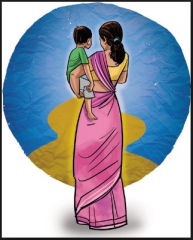
I have already written quite a lot about the experience of having a baby in India (1). In short, at the beginning, there is the mother-in-law, often present at birth, and she is often the first one to hold the newborn (before the mother this is true). Then the sister-in-law has to carry out a ritual – clean the mother’s nipples to purify them and give to the newborn a mixture made of honey (jatakarma) so he grows up all sweet with a sweet tooth – before breastfeeding can be initiated. The tone is thus set from the beginning: ‘parenting’ in India is more about ‘familying’, it is the job of about everyone in the family, if not especially the mother-in-law ( ;) ), which can upset the Western sensibility of a responsible mother who has her own views on what she wants or does not want for her child. Especially if she married to an Indian, and must comply with the rites like the naming ceremony or the head shaving (2).
The Indian son brought up, in the tradition, to never leave the family abode, his parents; in this sense he is and will always remain a ‘king boy’ all his life, kept away from any household chore – which makes guys who don’t even know not what a papaya looks like other than than in pieces on their plate, imagine. That’s the job of the women of the house: the mother, in whose petticoats he will always be hanging on except for a few misdemeanors to his wife’s, and then the latter. The Indian girl is brought up to be a good (obedient) daughter-in-law (maid) and especially a mother (she will only achieve her reason of being and earn her right to be on this Earth when she will give birth and this is apparently why we find in India the oldest primiparous women (3)); She will most likely leave her home for her husband’s and there is a good chance that she will not be able to work, even if she has done good studies (it is changing, but at a snail pace). She is taught to respect, obey, renounce being herself and especially swallow her feelings. If unfortunately a tragedy like a miscarriage happens, she is told that “there is no point crying, she should just forget and move on”. Mourning, letting her emotions flow? But this is madness! It is put a bit abruptly but it is quite like that.
Let us get back to the notion of ‘king boy’. French parents love their children, but they also try to limit the disruption their arrival means, in other words to not sacrifice their (entire) lives to their kids. For example the couple’s ‘intimacy’ is given a lot of importance and guides the sleeping organization. Which Westerner (except for the hipsters who are bringing back ‘co-sleeping’ 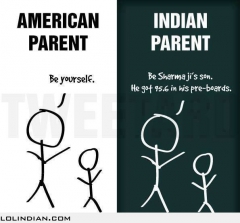 into fashion) would not be horrified by the mere idea that children sleep with their parents? And up to 4 years at least! I remember being shocked when I could not find a child’s room (to sleep or play) in my Indian colleague’s apartment which yet had to bedrooms. In India, children not only sleep in the same bed as their parents, but also at the same time. Talk of ‘food and sleep schedule’ or ‘sleep training’ and they look at you like a monster. Here children live to the rhythm of the household from their very first few hours and immediately the world starts spinning around them. It is very cultural: the couple has very little importance in India, lost in the more comprehensive concept of family (in-laws, children, cousins, all must live in harmony, and the couple (which is anyway in general made of reason and not love) must make all the efforts to make it happen). In most Western societies, the couple is the foundation, and we even conceive that the children’s well-being could depend on the happiness of the parental couple - in our individualistic Western world, happiness comes from the realization of the self, in India by doing your duty, and ALL the difference comes from here. The latter are not ashamed to go on a holiday without their little one. And no Indian person would even think of it (also because the notion of ‘holidays’ is fairly new and is generally limited to visit the family and not to laze on a beach or hike in the mountains (unless there is a temple to see)). Indians also bring very young kids to the (adult) movies, to shows where mythological monsters scare the shit of me, or even to bars. And to conclude, in India, we don't let kids cry, it’s a sin. Some say it would be beneficial to let youngsters express their feelings, anger or sadness, but I guess it just creates too much distress for the family here.
into fashion) would not be horrified by the mere idea that children sleep with their parents? And up to 4 years at least! I remember being shocked when I could not find a child’s room (to sleep or play) in my Indian colleague’s apartment which yet had to bedrooms. In India, children not only sleep in the same bed as their parents, but also at the same time. Talk of ‘food and sleep schedule’ or ‘sleep training’ and they look at you like a monster. Here children live to the rhythm of the household from their very first few hours and immediately the world starts spinning around them. It is very cultural: the couple has very little importance in India, lost in the more comprehensive concept of family (in-laws, children, cousins, all must live in harmony, and the couple (which is anyway in general made of reason and not love) must make all the efforts to make it happen). In most Western societies, the couple is the foundation, and we even conceive that the children’s well-being could depend on the happiness of the parental couple - in our individualistic Western world, happiness comes from the realization of the self, in India by doing your duty, and ALL the difference comes from here. The latter are not ashamed to go on a holiday without their little one. And no Indian person would even think of it (also because the notion of ‘holidays’ is fairly new and is generally limited to visit the family and not to laze on a beach or hike in the mountains (unless there is a temple to see)). Indians also bring very young kids to the (adult) movies, to shows where mythological monsters scare the shit of me, or even to bars. And to conclude, in India, we don't let kids cry, it’s a sin. Some say it would be beneficial to let youngsters express their feelings, anger or sadness, but I guess it just creates too much distress for the family here.
The Indian parents smolder their young; and yet they do not really arm them to survive in this world of brutes, to become independent, an individual; individuality occupies only a very small place in the Indian family structure. Right from the beginning for instance, the newborn is a ‘thing’ that is being passed from arm to arm, he ‘belongs’ to everyone, an extension of his parents which does not really have his own personality, still less a respected one. (I always surprise people when I let my two year old choose his clothes himself.) The smoldering is more physical where the mother hyper attentive to the needs of her baby: baby that she breastfeeds very late, that she massages every day, that they are always carrying. In India we are really in a 'contact' culture versus a 'hearing' Western environment where we leave babies lying down and watching the ceiling or a mobile toy and we teach them from a very early age to 'not be too attached' because the separation is going to come very soon. So in India the mother is so close to her child that she can even predict from a very early age to detect when he is going to shit and manage to potty-train him almost before his sphincters are sufficiently developed. A method consists in walking behind the kid with a newspaper, and slide it under the buttocks as soon as you can spot the signs of an imminent defecation. If you are not fast enough, you can then use the same paper to pick with the trophy. A complementary technique offers to let the baby hang around without diapers, playing in the sand pit and let his pee dry when it flows into the pants – I find it risky winter but how am I to talk potty-training? – apparently children learn fast in these cases. (And the economy of diapers relieves everybody: the wallet and the planet.)
When French mothers go to the park, they usually sit on a bench chatting while their small ones play around; and I find it fascinating. Indian mothers, if they were going to the park instead of sending the nanny, would spend their time running behind their kid. A bit like me so. But the height of it was when the Director of a babystore chain praised me the merits of an innovation that should be a big hit in India: a helmet to protect the back of the head when toddlers fall, because “you have no idea the number of mothers who spend their day running behind their offspring with a pillow so that they don’t let them hurt themselves when learning how to walk!” If that's not the summum of smoldering, I don’t know what is... (that being said I have personally never witnessed this kind of behavior).
And the food! The sinews of war, you will tell me. Feeding a child in France seems simple enough: he sits at the table, if he eats, all well, if he doesn’t eat, all well, he will get the same stuff at dinner. Feeding a child in India is just the opposite: parents and grand-parents spend their day putting who a piece of chapati, who a sugar cube, in the mouth of the small one, usually busy with other things. No wonder that Indian adults are the champions of snacking (and they often munch on fat fried stuff)! And then, at each visit, the first comments are usually on the weight of the child – knowing that in general the bigger better, where “chubby”" means “healthy”.
In a nutshell this is what the ‘king boy’ is: a kid that we don’t let cry, who is fed all the time.  Except that the king child gets a reality check pretty fast and it’s even harder as he was not prepared for it during his tender years. For example, when I told the story of my son calling his father by his first name for the first time, which I found very cute and funny, I was explained that at 2 it makes everyone laugh and at 5 he would get slapped for it. Indians seem to have a pretty heavy hand, slaps come easy and even teachers do not go at it with the back of the spoon – just like France a few decades ago. One must also highlights that in India, the ‘respect’ for elders is sacred. The king child is not God! It is therefore not a good idea to question one’s parents, worst to disobey them - so for a French who is used to question everything and everybody all the time, it is pretty hard to understand. The dialogue parents-children is sometimes difficult, in addition to the fact that certain topics are completely taboo, such as sexuality (and its abuses), alcohol, drugs etc. In short a lot of crucial discussions are avoided, because “we don’t talk about these things here”.It is also quite interesting to observe that living all together doesn't necessarily means communicating more or better, and it is quite the opposite actually. It is also compelling to see that Indians, who are by the way very emotional people, don't express much their feelings, and you often have to read between the lines. For instance, most Indian languages have no real word to express love, the love of a parent, a child, or even a partner. According to somebody close to me, love is expressed in India not by words but by actions, like "preparing somebody's favorite dish". And here we go, back to food, it’s crazy! (I could have argued said that in Europe one must use words AND gestures – it is a hard job ‘keeping love alive’.) In short in India we don’t say I love you and we don’t live crazy love stories, and that’s probably why people love a good marshmallow Bollywood movie: it sells them some dream (or rather fantasy)!
Except that the king child gets a reality check pretty fast and it’s even harder as he was not prepared for it during his tender years. For example, when I told the story of my son calling his father by his first name for the first time, which I found very cute and funny, I was explained that at 2 it makes everyone laugh and at 5 he would get slapped for it. Indians seem to have a pretty heavy hand, slaps come easy and even teachers do not go at it with the back of the spoon – just like France a few decades ago. One must also highlights that in India, the ‘respect’ for elders is sacred. The king child is not God! It is therefore not a good idea to question one’s parents, worst to disobey them - so for a French who is used to question everything and everybody all the time, it is pretty hard to understand. The dialogue parents-children is sometimes difficult, in addition to the fact that certain topics are completely taboo, such as sexuality (and its abuses), alcohol, drugs etc. In short a lot of crucial discussions are avoided, because “we don’t talk about these things here”.It is also quite interesting to observe that living all together doesn't necessarily means communicating more or better, and it is quite the opposite actually. It is also compelling to see that Indians, who are by the way very emotional people, don't express much their feelings, and you often have to read between the lines. For instance, most Indian languages have no real word to express love, the love of a parent, a child, or even a partner. According to somebody close to me, love is expressed in India not by words but by actions, like "preparing somebody's favorite dish". And here we go, back to food, it’s crazy! (I could have argued said that in Europe one must use words AND gestures – it is a hard job ‘keeping love alive’.) In short in India we don’t say I love you and we don’t live crazy love stories, and that’s probably why people love a good marshmallow Bollywood movie: it sells them some dream (or rather fantasy)!
It is mostly when school starts that children start realizing that life is no piece of cake. It can therefore begin early. In Europe we had to develop creches so that mothers could work and we ended up putting oursevelves some balm on the heart by convincing ourseveles that it is actually a choice, and it’s better for the children not to be at home from a young age – which I don’t believe to be entirely true. So in India, despite the fact that many mothers stay at home, surrounded by her in-laws and supported by the nanny, more and more hurry to put their offspring early in (pre)school,  “so that they develop grows faster”. An explanation that makes me jump every time, a systematic response when I ask why a mother who insists that I send my son since he turned 12 months to school. But why on earth do people always want to go faster than the music? Especially since once they are in the system, children face incredible pressure because competition is fierce and the seats are expensive: there are many young people and a huge poor class ready to fight to get out of the shit (they represent 70% of the population), not enough good institutions and quotas for lower castes, no unemployment insurance, no retirement scheme etc. In short, if you are not hungry enough to fight for survival, you're dead (unless your parents are super rich). Education is therefore a business, an ‘investment’ for which returns are clearly expected and which does not stop at the school which can cost a fortune: kids spend almost as much time (and parents spend almost as much money) in tuition! And the new trend is the extra-curricular activities: youngsters must be the best in class, and at playing tennis and the guitar. Not much respite for them.
“so that they develop grows faster”. An explanation that makes me jump every time, a systematic response when I ask why a mother who insists that I send my son since he turned 12 months to school. But why on earth do people always want to go faster than the music? Especially since once they are in the system, children face incredible pressure because competition is fierce and the seats are expensive: there are many young people and a huge poor class ready to fight to get out of the shit (they represent 70% of the population), not enough good institutions and quotas for lower castes, no unemployment insurance, no retirement scheme etc. In short, if you are not hungry enough to fight for survival, you're dead (unless your parents are super rich). Education is therefore a business, an ‘investment’ for which returns are clearly expected and which does not stop at the school which can cost a fortune: kids spend almost as much time (and parents spend almost as much money) in tuition! And the new trend is the extra-curricular activities: youngsters must be the best in class, and at playing tennis and the guitar. Not much respite for them.
In short, each parent gives their best at parenting don’t they? But in modern India, where society is changing fast and they have been integrating many Western concepts in conflict with a system of hard skinned traditions and values, it is easy to get lost when you try and bring up a child!
(1) http://www.indiandacoit.com/list/my-docs-about-india/babi... and http://www.indiandacoit.com/list/my-docs-about-india/baby-samourai-made-in-india.html
(2) http://www.bbc.co.uk/religion/religions/hinduism/ritesrituals/baby.shtml
(3) http://www.dailymail.co.uk/health/article-3582592/Indian-woman-70-gives-birth-baby.html
08:00 Posted in Expatriation (in India and in other countries), Little Samourai, Why in India... | Permalink | Comments (0) | Tags: india, parenting, education, upbringing, raising up children in india, society, respect, taboo, pressure | ![]() Facebook | |
Facebook | |
10/22/2013
Why in India there is a caste system?
After 7 years in India, I obviously wrote quite a bit on the subject (see below). I have sometimes been revolted against this system. I have accepted it. Ignored it. Forgotten it.
It is not so much this system – let us be realistic, every society is divided in social classes – but its rigidity that disturbs so much… Your caste (which you are born in) defines what you will do, eat, marry etc.
I have never really searched where this system comes from… 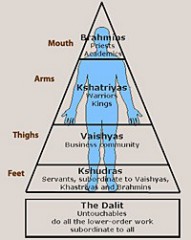
According to ancient Hindu books, human society was created from a body: the Brahmins would come from the head, the Kshatriyas from the hand, the Vaishias from the thighs and the Sudras from the feet. In some versions, the original body would be of a primeval giant, Purusha, sacrificed by the gods to create a human society; in others it would be Brahma.
All animated and inanimated things are believed to possess three qualities, in different proportions: Sattva, Rajas and Tamas. Brahmins would be loaded with Sattva qualities (which include wisdom, intelligence, honesty, goodness and other positive qualities); Kshatriyas and Vaishias with Rajas qualities (passion, pride, valour and other passionate qualities); Sudras with Tamas qualities (dullness, stupidity, lack of creativity and other negative qualities). Hence the different occupations that each people would occupy. And the different diets and different dosages of food they would need to develop their inherent qualities. For instance meat is considered Tamasic food but also Rajasic.
It seems likely to me that these two explanations were developed to support a system with social-historic roots. Which brings us back somewhere around 2000 years BC when the Harappan civilization of the Indus Valley started to decline and the Aryans (Indo-European speakers from Central Asia), a group of warrior nomads began to migrate. There is no agreement between scholars whether “the Aryans and Harappans mixed together and became peaceful, or the Aryans came in as a conquering people, became the ruling class, and instituted the caste system to maintain control”.
However, and this is my personal observation, the stratification of the society in India is clearly linked to the skin colour. The fairer the higher in caste, the smarter, the richer, the more beautiful. At least it is perceived like this. And it’s no new thing. One should see how a baby can stare at a white person. And I have met very few Indians who don’t have, somewhere, an inferiority – totally unjustified and difficult to understand for me – complex toward white skinned. And I don’t think it can only be the result of the British colonisation… Just read old Hindu religious stories: “there are many wars between the good Aryans and the dark skinned demons and devils”.
Somehow the organisation of the Aryans in three groups (the Rajayana which became the Kshatrias (warriors), the Brahmins (priests) and the Vaisias (farmers and craftsmen) , which is pretty logical and easy to adopt, spread on to the local society. Later on, “communities who professed non-polluting jobs were integrated in Sudra Varna and communities who professed polluting professions were made outcasts”.
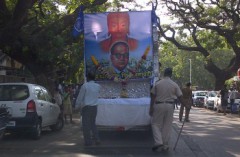 So it was convenient for the rules to keep the system that way – as it would be for any ruler in any society. Rules were strict and abided by. Religion (as Hinduism is mostly a canvas of superstitions) was also used to keep everyone on the right track in fear of retaliation. And what makes India different from other countries is that people don’t really rebel against the order of things, and neither does religion decline. They do at times – see how the Untouchable Ambedkar encouraged Hindus to convert to Buddhism in reaction to the caste system, and how such conversions of dalits still happen nowadays, for instance for the 50th anniversary of the leaders’s death* – but fundamentally the society remains the same…
So it was convenient for the rules to keep the system that way – as it would be for any ruler in any society. Rules were strict and abided by. Religion (as Hinduism is mostly a canvas of superstitions) was also used to keep everyone on the right track in fear of retaliation. And what makes India different from other countries is that people don’t really rebel against the order of things, and neither does religion decline. They do at times – see how the Untouchable Ambedkar encouraged Hindus to convert to Buddhism in reaction to the caste system, and how such conversions of dalits still happen nowadays, for instance for the 50th anniversary of the leaders’s death* – but fundamentally the society remains the same…
Is the caste system still present and visible in cities?
“Either it doesn’t really prevails in my world (personal and professional), either it is too subtle for me – at the same time I don’t really dig”.
However read my story of the fat superior Indian giving a lesson to a waiter:
(24/04/2013)
Do Indian people rebel against this system?
“In the countryside, the caste system prevails.
Read the story of Sampat Pal, a shepherdess who, with her Pink Sari gang, rebelled against the injustices inflicted to lower castes by higher castes or to women by men, against corruption and stealing of subsidised food, lands, jobs which the Government reserves for the poorest.”
(20/04/2013)
The issue of castes and quotas in today’s society
“The Indian Constitution prohibits discrimination based on caste.
That said it does not belong to the Government to abolish such a system because it is related to religion. As a matter of fact, the last census (2011) included a (optional) question about the caste.
Casteism is a pillar of Hinduism: "the fulfilment of one personal duty to the caste - and not a universal duty - and the system of reincarnation in a higher or lower caste as a reward for your good or bad actions are the two fundamental pillars of this religion until the final liberation and paradise.")
To fight this discrimination, the Government has implemented quotas for access to education, civil servant positions, political seats. There even has been an untouchable president (K. R. Narayanan).
The problem is that today it is all mixed up and ultimately these quotas are based on the social status (caste) of people but not on the merit or the income. And as low and out-castes form a majority, politicians are struggling to change this system...”
www.indiandacoit.com/archive/2013/04/22/about-casts-and-inequalities-in-india-the-big-picture.html
22/04/2013
What about the lower castes and outcastes? And how do Westerners see it?
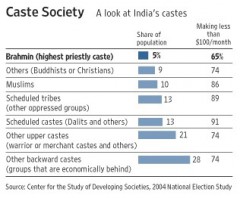 In India people referred to other compatriots as “uneducated” all the time. A term a bit shocking to a French. As the word “backward” to refer to a class of people in the lower castes.
In India people referred to other compatriots as “uneducated” all the time. A term a bit shocking to a French. As the word “backward” to refer to a class of people in the lower castes.
“According to the last census (source: http://www.censusindia.gov.in/2011census) « Intouchables » and the tribes represent 30% of the Hindu population / 24% of the Indian population. And if you add the ‘feet’ (kshudras or lower castes) you get 54% of the population.”
http://www.indiandacoit.com/archive/2011/04/14/and-you-what-s-your-little-name.html#more 04/05/2011
Marc Boulet wrote “In the skin of an Intouchable” – he basically learned Hindi perfectly, took drugs to get a tan and lived on the street as an Intouchable beggar for months…
“Westerners completely fall for it. They rightly fight racism and anti-Semitism but they see the caste system with a lot of indulgence and consider that it is part of the Indian cultural heritage, like the Tâj Mahal. They don’t get shocked, outraged, by the caste system; it is far away. And I also think that their benevolence comes from the fact they admire the brahman civilisation and they get disgusted by sweepers and other untouchables, altogether with beggars and lepers for whom they only think of a contemptuous charity. […] I am not scared of words anymore. The caste system is a segregationist system, just as Apartheid in South Africa. As revolting, as condemnable.”
http://www.indiandacoit.com/archive/2011/05/04/untouchables-again.html
14/04/2011
http://adaniel.tripod.com/origin.htm
http://www.thenagain.info/webchron/india/AryanMig.html
http://www.ambedkar.org/Babasaheb/Why.htm
08:00 Posted in Why in India... | Permalink | Comments (0) | Tags: india, ambedkar, caste, castes, cast system, religion, society, census, lower castes, outcasts, pink sari gang, backward, marc boulet, casteism, hinduism, sattva, rajas, tamas, aryans, fair, skin complexion, white | ![]() Facebook | |
Facebook | |














